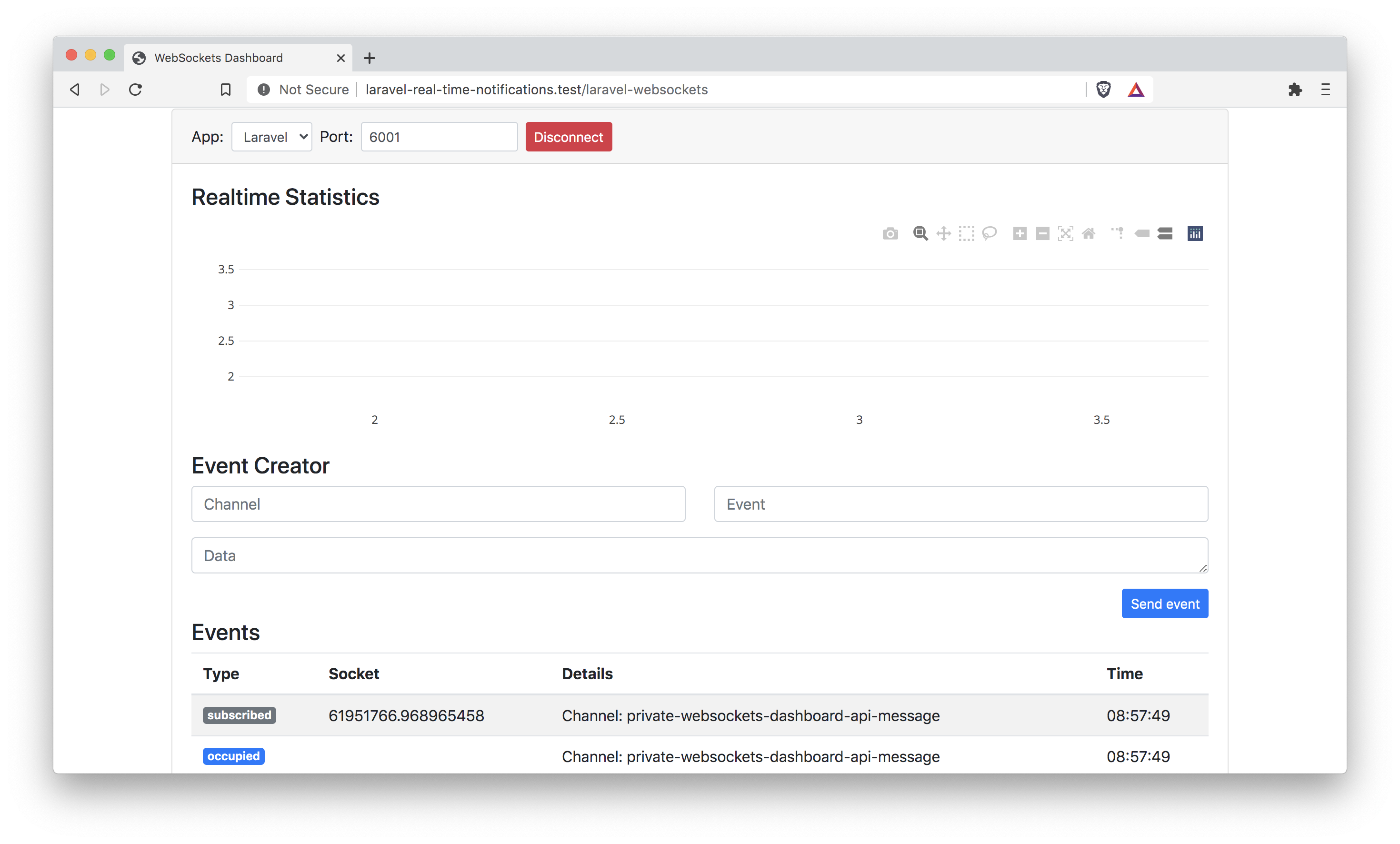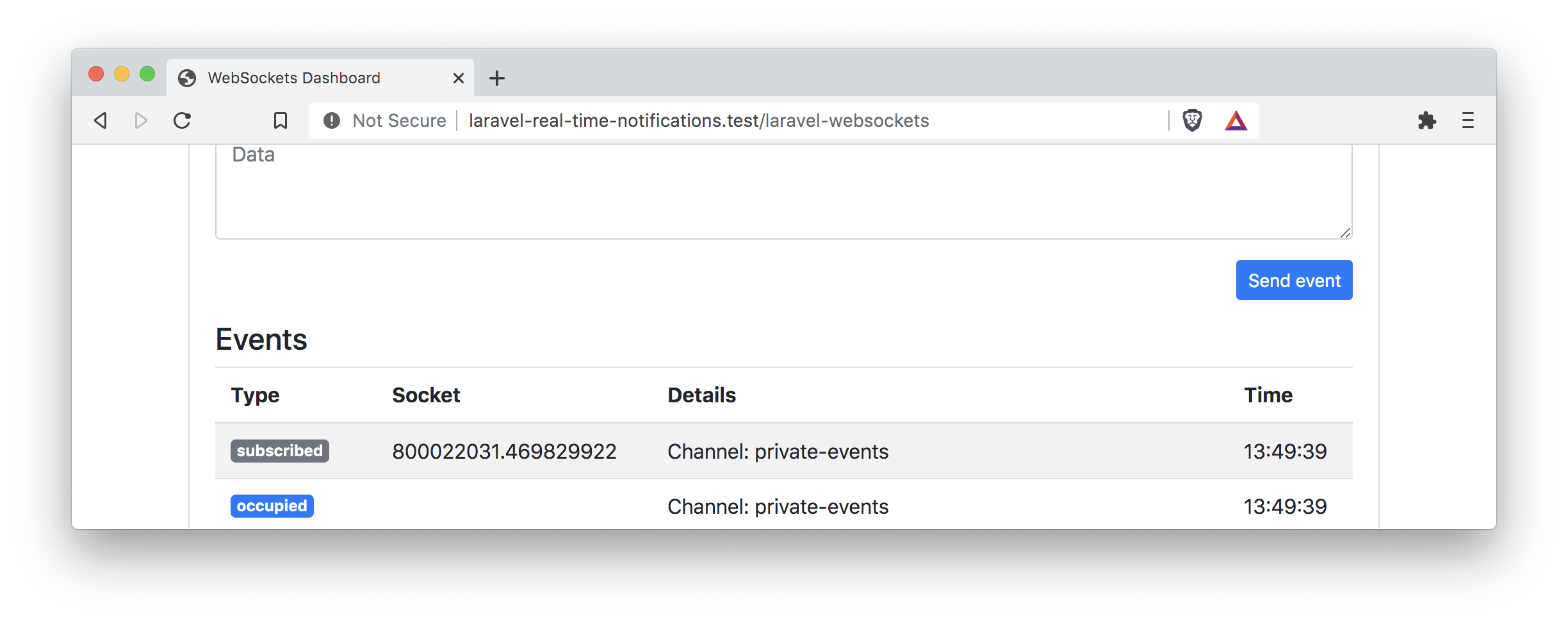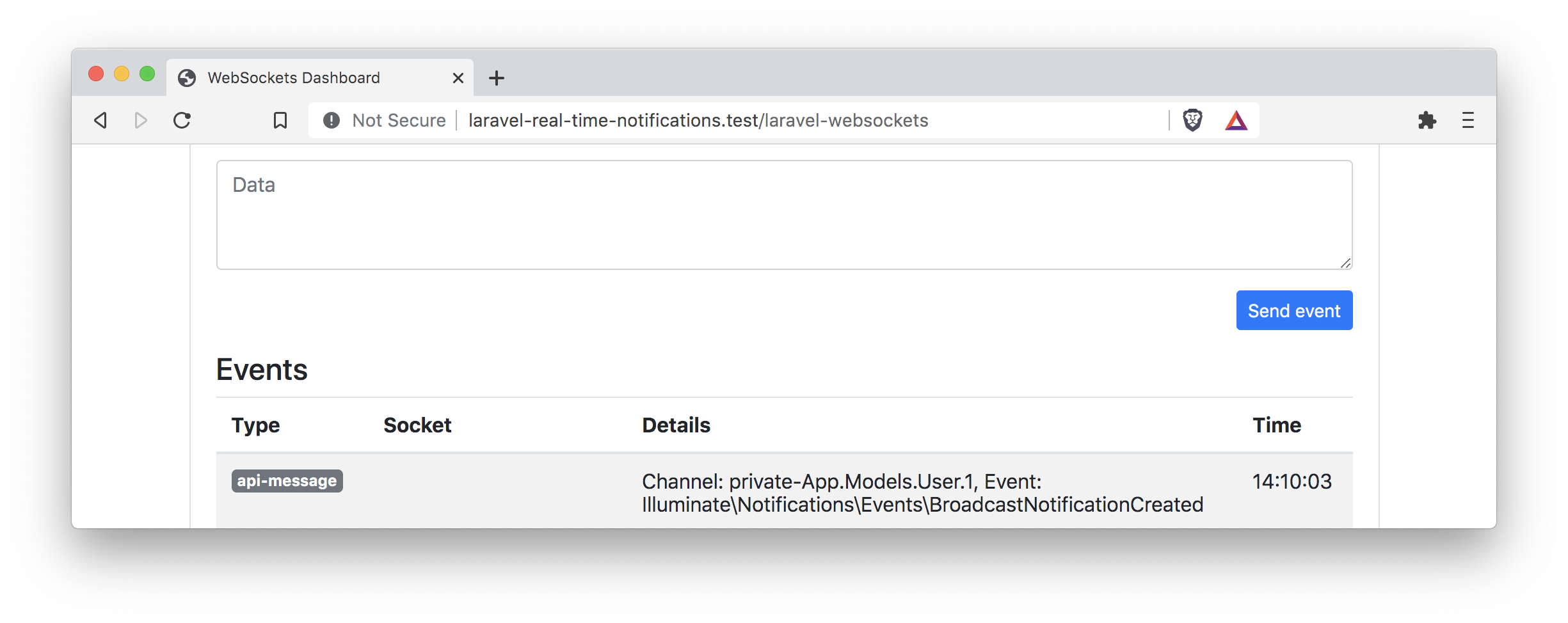Laravel Popup Login Form Relaunch on Error Updated FREE
Laravel Popup Login Form Relaunch on Error
In this postal service, we will accept a look at how we tin send real-time notifications with Laravel, the Laravel Websockets package, and Laravel Echo.

HTTP is stateless. Ordinarily, the client asks for a URL, and the server returns the data. Only a refresh of the page can load new data. About of the fourth dimension, this is enough, only sometimes nosotros demand more.
Today, many tasks happen on the backend, and we sometimes need to inform the user nigh information technology correct away. And so there is a use-case for triggering an action from the server instead of the client. Call up of messaging in a chat or notification messages that pop up on the elevation of your dashboard.
To achieve this, our customer could ask the server every second if something new happened, or you could make use of long polling. Just the best solution is to create a new communication channel through WebSockets which works in both means.
Today we are going to build an awarding with real-time messaging. We will use a WebSocket solution chosen Laravel Websockets, built in PHP.
Hither is a preview of what we are going to built today:

If you're just interested in the lawmaking, bank check it out here.
Installation
We start by creating a new Laravel 8 application. I always recommend using the Laravel Installer for this purpose.
laravel new laravel-existent-fourth dimension-notifications To achieve our goal of sending real-fourth dimension notifications, nosotros need to make 3 parts work together:
- Sending/broadcasting notifications from our Laravel application
- A WebSockets server that receives those notifications
- Our front-end that listens to the WebSockets server
Let's showtime with the WebSockets server.
Installing Laravel Websockets
Require the Laravel Websockets parcel. It works as a replacement for external services like Pusher. Many settings will refer to Pusher today simply exist reminded that we are not using it. We want our own solution.
composer require beyondcode/laravel-websockets We likewise need a package by Pusher.
composer require pusher/pusher-php-server Adjacent, arrange your .env file. We desire the BROADCAST_DRIVER to be pusher.
BROADCAST_DRIVER=pusher Note: Again I want to mention that we do non use the Pusher service. Our websockets server simply has the same API.
And we demand to fix the Pusher credentials.
PUSHER_APP_ID=12345 PUSHER_APP_KEY=12345 PUSHER_APP_SECRET=12345 PUSHER_APP_CLUSTER=mt1 We can ascertain all those values ourselves. We are not actually using Pusher, but the package uses these keys, and then it makes replacing Pusher (if you use it) as simple as possible.
Annotation: Make certain to utilize more than random values when using in production.
The Laravel Websockets package comes with a migration file for storing statistics and a config file we demand to adapt. Let'south publish them.
php artisan vendor:publish --provider="BeyondCode\LaravelWebSockets\WebSocketsServiceProvider" --tag="migrations" This volition create a new migration file that nosotros tin run. Make sure you have gear up a database for this project and divers the DB credentials in the .env file. Afterwards, we can run the migration.
php artisan migrate And hither, we publish the config file of Laravel Websockets.
php artisan vendor:publish --provider="BeyondCode\LaravelWebSockets\WebSocketsServiceProvider" --tag="config" Now nosotros are ready to start the WebSockets server.
php artisan websockets:serve To test that it is running, nosotros can check the debugging dashboard under the endpoint /laravel-websockets. You can click connect to see if the dashboard can connect to the WebSockets server.

After clicking connect, y'all should see that the dashboard is subscribed to some debugging channels like individual-websockets-dashboard-api-message. This will tell you lot that the server is set correctly.
Circulate Notifications From Our Laravel Application
There are ii means nosotros tin can send letters from our backend to the WebSockets server:
- Laravel Events
- Laravel Notifications
We will start with events because this is a niggling easier. Later we volition check notifications equally well.
Let'due south create a new upshot with artisan.
php artisan brand:consequence RealTimeMessage Here is what nosotros demand to change:
- use the
ShouldBroadcastinterface - add a message property which we will laissez passer through the constructor
- return a new
Channelinstead of aPrivateChannel - give the channel the name
eventsinstead ofaqueduct-name
<?php namespace App\Events; utilize Illuminate\Broadcasting\Aqueduct; apply Illuminate\Contracts\Broadcasting\ShouldBroadcast; employ Illuminate\Queue\SerializesModels; grade RealTimeMessage implements ShouldBroadcast { employ SerializesModels; public string $message; public function __construct (string $message) { $this->message = $bulletin; } public part broadcastOn (): Channel { return new Channel('events'); } } Annotation: You may noticed that we didn't define a listener like we usually do with an event. This is because nosotros are using the websockets server.
Before we can try sending this upshot, please accommodate your broadcasting.php config file to utilise the following options:
'options' => [ 'cluster' => env('PUSHER_APP_CLUSTER'), 'encrypted' => false, 'host' => '127.0.0.1', 'port' => 6001, 'scheme' => 'http' ], With these options, nosotros make sure that when we broadcast something from our Laravel awarding, it gets sent to our WebSockets server.
Note: Nosotros practice not use TLS for our demo, just we will take a look at that later likewise.
Now we can trigger our created event RealTimeMessage with the global event helper. I recommend using tinker or Tinkerwell to do that for our demo, but you could also create a route and run the command at that place.
event(new App\Events\RealTimeMessage('Hello World')); Of class, in a real application, you would run this inside a controller or activity course. Later on running this command, you should encounter a new entry on the debug dashboard.

Listen To Letters From Our Front-cease
We accept made sure that our sent upshot is broadcasted to the WebSockets server. But at present we want to listen to it and then that we can utilise the message on our front-end. We are going to use the JavaScript library Laravel Repeat for that purpose.
Permit'due south commencement by installing information technology together with the pusher library, which we volition need too.
npm install --save-dev laravel-echo pusher-js The resouces/js/bootstrap.js file of Laravel already contains a lawmaking snippet for creating a new instance of Laravel Echo we tin use. Annotate information technology in and add the wsHost and wsPort.
import Repeat from 'laravel-echo'; window.Pusher = require('pusher-js'); window.Echo = new Echo({ broadcaster: 'pusher', key: process.env.MIX_PUSHER_APP_KEY, cluster: process.env.MIX_PUSHER_APP_CLUSTER, forceTLS: fake, wsHost: window.location.hostname, wsPort: 6001, }); The bootstrap.js file is required by Laravel's main resources/js/app.js file. This means we need to run npm run dev to bundle our Repeat lawmaking with the chief JS file.
Now import the script. We are going to apply Laravel's welcome view for our tutorial. So add the app.js file into your view, right before the terminate of the body tag.
<script src="{{ asset('js/app.js') }}"> </script> As well, open a new script tag where we create our Echo listener. Nosotros listen to the channel events and for the grade proper name of the event we created. If we receive an update, nosotros write a message to the console.
<script> Echo.aqueduct('events') .listen('RealTimeMessage', (eastward) => console.log('RealTimeMessage: ' + e.message)); </script> When you refresh the browser'due south welcome page, you lot should too go an update on the debug dashboard.

It shows that we are successfully subscribed to the events channel. This means we are ready to give information technology a existent endeavor!
Sending Real-Time Messages
Now that nosotros prepared our event, the WebSockets server, and our JavaScript listener, nosotros tin give a real effort. Then back inside tinker or Tinkerwell, we can trigger our result again.
consequence(new App\Events\RealTimeMessage('Hi Globe')); Now we not but meet the bulletin in the debug dashboard but likewise in the console output. And then we were able to receive data on our front-end, without refreshing the page or making an ajax call. This is our first existent-time message. 🥳

Allow'southward Talk Privately
Next to sending messages to a public channel, we tin can also employ a private ane with events. Permit's alter our RealTimeMessage consequence to use a private channel.
public office broadcastOn (): Channel { render new PrivateChannel('events'); } Now send the issue again.
Annotation: If you are using Laravel Tinker, make sure to restart it because of the changes we made in our result.

As y'all can see in the debug dashboard, our message was at present sent on a private channel. Nice! But at present we also need to mind to a private channel. Luckily, Laravel Echo lets united states of america likewise change the channel method to private.
Echo.private('events') .listen('RealTimeMessage', (e) => panel.log('Individual RealTimeMessage: ' + e.message)); But when you lot refresh the welcome folio, you see that we get an error.

The problem here is that private channels need to exist authenticated. That'south what Laravel Echo is trying to practise past requesting the /dissemination/auth endpoint. But the endpoint is not defined. Nosotros need to include it by uncommenting the BroadcastServericeProvider in our app.php config file.
/* * Application Service Providers... */ App\Providers\AppServiceProvider::class, App\Providers\AuthServiceProvider::grade, App\Providers\BroadcastServiceProvider::class, // Nosotros enabled this class App\Providers\EventServiceProvider::class, App\Providers\RouteServiceProvider::class, Refresh the folio again, and you will encounter the mistake from before is gone, but of course, there is a new one :-)

The endpoint is at present defined, but it returns a 419 error. This ane is most the csrf token. Nosotros need information technology to verify this request. Here nosotros don't have a form where we usually use information technology, just we can add information technology to our HTML head in a meta tag.
<meta name="csrf-token" content="{{ csrf_token() }}"> Again we were able to solve a trouble, and also we run across a new error. Just trust me, we are getting shut now :-)

This time we received a 403 fault telling usa we are not allowed to mind to the individual aqueduct. This is good because we haven't told Laravel nevertheless who is immune to heed to this private channel.
Next to the circulate routes, the BroadcastServiceProvider also activates the routes/channels.php file. Here is where we define who is allowed to access a private channel. There is already an example, just nosotros add our own aqueduct check now.
Circulate::aqueduct('events', role ($user) { return truthful; }); We tell Laravel that we do not take specific rules for authenticating who can subscribe to our private aqueduct. Merely when you refresh the welcome page, yous will still encounter a 403 error. This is because i affair is the same for every private aqueduct: There must be a logged-in user.
And so let'southward add together a new user to the database. I'k using Tinkerwell again hither. We do not care well-nigh the user details.
User::create([ 'proper name' => 'Test user', 'email' => 'test@test.at', 'password' => bcrypt('test'), ]); Nosotros tin log this user into our application earlier we return the welcome view in the spider web.php route file. Also, brand sure to import the User grade earlier yous utilise it.
Route::go('/', function () { auth()->login(User::first()); return view('welcome'); }); This will log in the first user from our users table. Reload the welcome page, and you lot volition no longer find an error in the panel. Y'all will besides run across that nosotros are now subscribed to the private events channel in the debug dashboard.

Trigger the outcome over again, and we will receive the private message output in the panel.
event(new App\Events\RealTimeMessage('Hello Earth')); 
Notifications
The title of this blog contains Notifications, so what nearly them? You lot might know I'k a big fan of Laravel'south notification arrangement, and then for sure, we are talking virtually them besides.
So adjacent to events, we can use notifications to send data to our WebSockets server. So let's create a new one.
php artisan make:notification RealTimeNotification Hither is what we need to change:
- use the
ShouldBroadcastinterface - add a bulletin belongings which we will pass through the constructor
- apply the
circulatechannel in theviamethod - add a
toBroadcastmethod to ascertain the message
<?php namespace App\Notifications; utilize Illuminate\Contracts\Broadcasting\ShouldBroadcast; use Illuminate\Notifications\Messages\BroadcastMessage; use Illuminate\Notifications\Notification; grade RealTimeNotification extends Notification implements ShouldBroadcast { public string $message; public function __construct (string $message) { $this->bulletin = $message; } public function via ($notifiable): array { return ['broadcast']; } public role toBroadcast ($notifiable): BroadcastMessage { render new BroadcastMessage([ 'message' => "$this->message (User $notifiable->id)" ]); } } Since notifications are always connected to a notifiable model (like a user), we have access to it inside the toBroadcast method. This way I can add the user id to the message nosotros sent.
Note: There are also on-need notifications where you exercise not demand a notifiable, but this is not supported in combination with broadcasting.
Alright, time to trigger our notification. Again, we are using the 1 user we have in our database.
$user = User::first(); $user->notify(new App\Notifications\RealTimeNotification('Hello Earth')); 
You probably noticed that we did not define a aqueduct name with our notification equally we did in our event. This is considering there is a default pattern for the channel name of a notification notifiable-class.central. In our case, this would exist App.Models.User.1. And when you take a look at the Spider web dashboard, you lot discover a bulletin triggered by our notification to the aqueduct Channel: private-App.Models.User.one.
Next, let's subscribe to this channel in our forepart-end. Laravel echo has a notification method nosotros can brand apply of.
Echo.private('App.Models.User.one') .notification((notification) => { console.log(notification.message); }); You lot should be able to refresh the welcome page now without seeing any errors. Since we are using a private channel again, Laravel Repeat will effort to authenticate our subscribing request to this channel. This is where the other code-snippet from the channels.php file comes into play.
Broadcast::aqueduct('App.Models.User.{id}', office ($user, $id) { return (int) $user->id === (int) $id; }); It will make sure when y'all endeavor to subscribe to a specific user's private channel that the provided id is the same equally the logged-in user. You tin easily force an error when you try to mind to a different user id similar:
Repeat.individual('App.Models.User.99') .notification((notification) => { panel.log(notification.message); }); When y'all refresh the welcome folio, y'all volition see that we get a 403 error once again. But now, let'southward finish this example by triggering the notification also at present.

And this is how we tin can circulate real-time messages with notifications as well. The do good of notifications is that y'all can send them through multiple channels. Then you can ship a real-time message to the user's dashboard about a newly created invoice and transport an email while but using i notification form.
More than Tips & Tricks
SSL Back up
Of course, you will use a secure connection with your live applications. Our example will piece of work there, too, with some additions. Therefore, I have created a new branch called feature/useTls. These settings helped me to make this app piece of work on a secure locally Laravel Valet site.
Annotation: If you use this co-operative, make sure to modify the certificate paths to your own ones in the websockets config file.
I saw many users struggling with the SSL back up setup with Laravel Websockets and Laravel Echo, and I have to admit it tin can be tricky because of different SSL settings. I promise my branch will give you lot a good beginning. Additionally, here are the docs for SSL support for Laravel Websockets.
Events Or Notifications
As I showed yous, both options give you lot a lot of flexibility when sending real-fourth dimension messages. I'd recommend notifications if you already work with logged-in users in your application.
If you practice not piece of work with users/notifiables in your application, events requite yous an excellent way of sending letters to a channel you can define.
Conclusion
I hope this long commodity could requite y'all a swell outset into existent-fourth dimension messaging with Laravel. Am I missing more details? What are your thoughts on Laravel and real-time messaging? Permit me know on Twitter.
As always, brand sure to check the official docs for all the tools we used today:
- Broadcast Laravel Events
- Circulate Laravel Notifications
- Laravel Echo
- Laravel Websockets Package
All the lawmaking for our demo application can exist establish in this repository.
Laravel Popup Login Form Relaunch on Error
DOWNLOAD HERE
Source: https://christoph-rumpel.com/2020/11/laravel-real-time-notifications
Posted by: kyleperat1945.blogspot.com